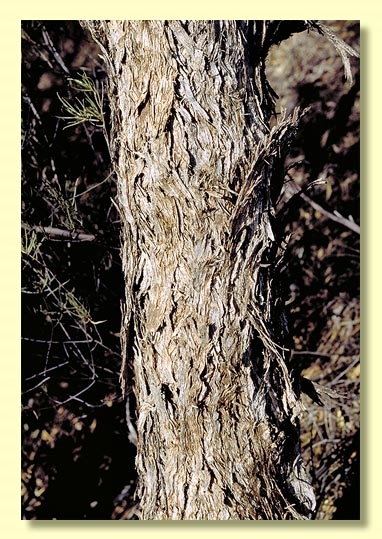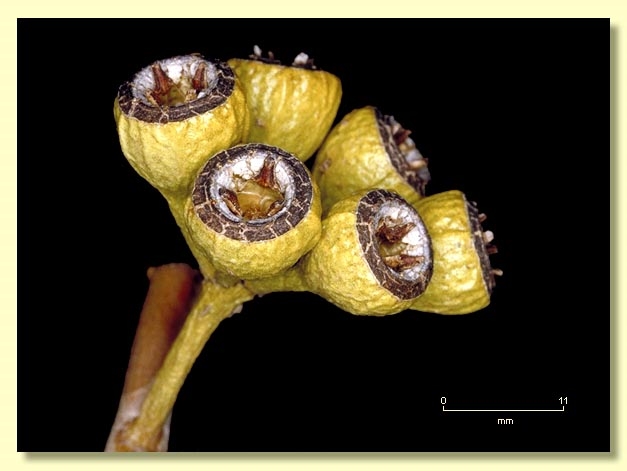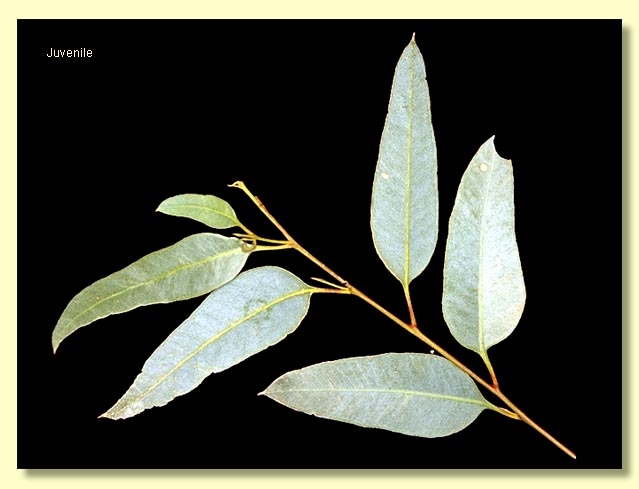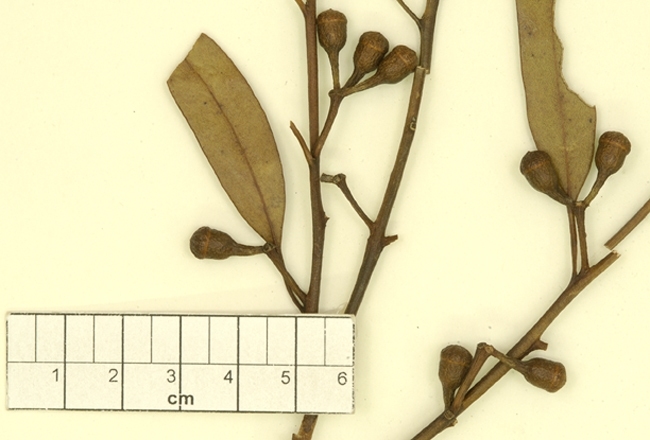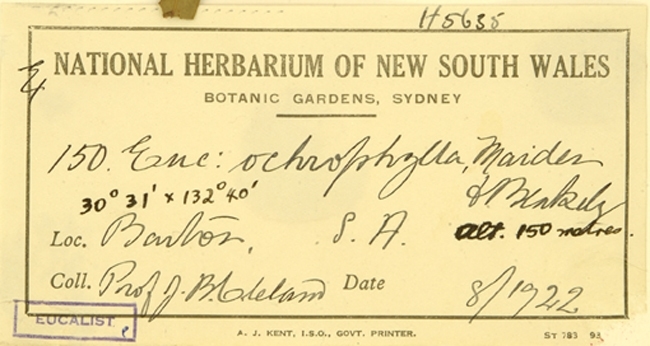Eucalyptus | Symphyomyrtus | Dumaria | Corrugatae
Euclid - Online edition
Eucalyptus concinna
T: Camp 49, Great Victoria Desert, W.A., 12 Sept. 1891, R.Helms s.n. ; holo: NSW; iso: K, PERTH.
Eucalyptus ochrophylla Maiden & Blakely in J.H.Maiden, Crit. Revis. Eucalyptus 8: 50 (1929). T: Immarna, near Ooldea, S.A., 29 Aug. 1922, J.B.Cleland 67; syn: NSW; Ooldea, S.A., 27 Aug. 1922, J.B.Cleland 71; syn: NSW; Ooldea, S.A., Aug. 1922, J.B.Cleland 72; syn: NSW; Ooldea Soak, S.A., 27 Aug. 1922, J.B.Cleland 68; syn: AD, NSW; E of Ooldea, S.A., June 1909, H.Deane s.n.; syn: NSW; Barton, S.A., 23 Aug. 1922, J.B.Cleland 66; syn: CANB, NSW; (see image of type specimen held at CANB) 70 miles [ca 112 km] SW of Camp 17, Elder Exploring Expedition, 17 July 1891, R.Ramsay s.n.; syn: MEL, NSW; Comet Vale, W.A., Sept. 1909, J.H.Maiden s.n.; syn, NSW.
Eucalyptus meeboldii Blakely, Key Eucalypts 121 (1934). T: 7 miles [ca 11 km] W of Kalgoorlie, W.A., June 1933, A.Meebold; holo: NSW; iso: MEL, PERTH.
Bark rough grey-brown, thick to flaky or scaly for up to half of trunk, or sometimes entirely smooth, pale grey over coppery.
Branchlets with oil glands in the pith.
Juvenile growth (coppice or field seedlings to 50 cm tall): stems square in cross-section with slight waxy bloom; juvenile leaves always petiolate, opposite for few nodes then alternate, ovate to broadly lanceolate, 4.5–8 cm long, 2.3–3.7 cm wide, base tapering, lower leaves glaucous but after roughly 0.3–1 m of growth leaves become grey-green to green.
Adult leaves alternate, petioles 1–2 cm long; blade lanceolate to narrowly lanceolate, 7.3–14 cm long, 0.8–2 cm wide, base tapering to petiole, concolorous, glossy, green, side-veins at an acute or wider angle to midrib, densely reticulate, intramarginal vein close to margin, oil glands intersectional, numerous.
Inflorescence axillary unbranched, peduncles 0.7–1.5 cm long, buds 7, 9 or 11 per umbel, pedicels 0.2–0.9 cm long. Mature buds oblong to obovoid or pear-shaped (0.6–1.2 cm long, 0.4–1 cm wide), green-brown, scar present, operculum wider than the hypanthium at the join, conical, rounded, flattened or turban-shaped (0.2–0.4 cm long), radially striate or smooth, stamens inflexed, anthers cuneate, versatile, dorsifixed, dehiscing by longitudinal slits (non-confluent), style long, stigma blunt, locules 3 to 5, the placentae each with 4 vertical ovule rows. Flowers white.
Fruit pedicellate (pedicels 0.1–0.8 cm long), usually cup-shaped to obconical, 0.5–1.2 cm long, 0.6–1.1 cm wide, sometimes slightly ribbed, disc level or descending, valves 3 to 4(5), usually exserted.
Seed dark brown to almost black, 1–2.5 mm long, ovoid or flattened ovoid, the dorsal surface pitted, hilum ventral.
Cultivated seedlings (measured at ca node 10): cotyledons reniform; stems rounded to square in cross-section; leaves always petiolate, opposite for 4 or 5 nodes then alternate, lanceolate, 6.5–10.5 cm long, 2–3.5 cm wide, dull, grey-green to green.
Flowering has been recorded in April, September, October and November.
A mallee of widespread distribution in desert areas away from the coast, from north-west of Kalgoorlie in Western Australia, eastwards and north of the Nullarbor Plain to the Gawler Ranges west of Port Augusta in South Australia. It occurs on sand-dunes and sandplain. The bark is rough on the lower stems, less commonly entirely smooth. The adult leaves are very glossy green with numerous conspicuous oil glands.
Eucalyptus concinna belongs in Eucalyptus subgenus Symphyomyrtus section Dumaria because the buds have two opercula, stamens are strongly inflexed, ovules are in four rows on the placentae and cotyledons are reniform. Within this larger grouping E. concinna and six other species— E. melanoxylon, E. brachycalyx, E. corrugata, E. griffithsii, E. rugosa and E. laevis—form a sub-group called series Corrugatae, all with ovoid, conspicuously pitted seeds and with dark brown oil glands in the pith of the branchlets.
E. concinna is distinguished from these near relatives by the combination of rough lower trunks and flat-topped buds in umbels of seven to 11. If smooth-barked it is most likely to be confused with E. griffithsii, a species restricted to the central goldfields of W.A., which has larger buds in clusters of three.


